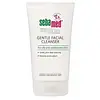What's inside
What's inside
 Key Ingredients
Key Ingredients

No key ingredients
 Benefits
Benefits

 Concerns
Concerns

 Ingredients Side-by-side
Ingredients Side-by-side

Water
Skin ConditioningDisodium Laureth Sulfosuccinate
CleansingCocamidopropyl Betaine
CleansingDisodium Cocoamphodiacetate
CleansingGlyceryl Laurate
EmollientPEG-7 Glyceryl Cocoate
EmulsifyingSodium Chloride
MaskingPEG-120 Methyl Glucose Dioleate
EmulsifyingPhenoxyethanol
PreservativePEG-150 Distearate
EmulsifyingGlycerin
HumectantPanthenol
Skin ConditioningParfum
MaskingSodium Benzoate
MaskingCitric Acid
BufferingAllantoin
Skin ConditioningHamamelis Virginiana Bark/Leaf/Twig Extract
Skin ConditioningCoco-Glucoside
CleansingMenthol
MaskingGlycol Distearate
EmollientTetramethyl Acetyloctahydronaphthalenes
MaskingWater, Disodium Laureth Sulfosuccinate, Cocamidopropyl Betaine, Disodium Cocoamphodiacetate, Glyceryl Laurate, PEG-7 Glyceryl Cocoate, Sodium Chloride, PEG-120 Methyl Glucose Dioleate, Phenoxyethanol, PEG-150 Distearate, Glycerin, Panthenol, Parfum, Sodium Benzoate, Citric Acid, Allantoin, Hamamelis Virginiana Bark/Leaf/Twig Extract, Coco-Glucoside, Menthol, Glycol Distearate, Tetramethyl Acetyloctahydronaphthalenes
Water
Skin ConditioningPolysorbate 20
EmulsifyingSaccharide Isomerate
HumectantGlycerin
HumectantPropylene Glycol
HumectantSodium Hyaluronate
HumectantHydrolyzed Silk
HumectantCucumis Sativus Fruit Extract
EmollientHamamelis Virginiana Bark/Leaf Extract
AstringentAllantoin
Skin ConditioningMenthol
MaskingFarnesol
PerfumingCaramel
Cosmetic ColorantParfum
MaskingSodium Lactate
BufferingPhenoxyethanol
PreservativePotassium Sorbate
PreservativeSodium Benzoate
MaskingCI 42090
Cosmetic ColorantWater, Polysorbate 20, Saccharide Isomerate, Glycerin, Propylene Glycol, Sodium Hyaluronate, Hydrolyzed Silk, Cucumis Sativus Fruit Extract, Hamamelis Virginiana Bark/Leaf Extract, Allantoin, Menthol, Farnesol, Caramel, Parfum, Sodium Lactate, Phenoxyethanol, Potassium Sorbate, Sodium Benzoate, CI 42090
Ingredients Explained
These ingredients are found in both products.
Ingredients higher up in an ingredient list are typically present in a larger amount.
Allantoin is a soothing ingredient known for its protective and moisturizingg properties. Because of this, it is often added to products with strong active ingredients.
Studies show higher concentrations of this ingredient can promote wound healing.
Though it can be derived from the comfrey plant, allantoin is produced synthetically for cosmetic products to ensure purity.
Learn more about AllantoinGlycerin is already naturally found in your skin. It helps moisturize and protect your skin.
A study from 2016 found glycerin to be more effective as a humectant than AHAs and hyaluronic acid.
As a humectant, it helps the skin stay hydrated by pulling moisture to your skin. The low molecular weight of glycerin allows it to pull moisture into the deeper layers of your skin.
Hydrated skin improves your skin barrier; Your skin barrier helps protect against irritants and bacteria.
Glycerin has also been found to have antimicrobial and antiviral properties. Due to these properties, glycerin is often used in wound and burn treatments.
In cosmetics, glycerin is usually derived from plants such as soybean or palm. However, it can also be sourced from animals, such as tallow or animal fat.
This ingredient is organic, colorless, odorless, and non-toxic.
Glycerin is the name for this ingredient in American English. British English uses Glycerol/Glycerine.
Learn more about GlycerinMenthol is a compound found in mint plants, such as peppermint. In its pure form, it is a clear crystalline substance.
Menthol is known for its cooling sensation; however, the cooling is actually from your skin being sensitized. Menthol can worsen rosacea. We recommend speaking with a professional if you have concerns.
Menthol also has antimicrobial properties.
Learn more about MentholParfum is a catch-all term for an ingredient or more that is used to give a scent to products.
Also called "fragrance", this ingredient can be a blend of hundreds of chemicals or plant oils. This means every product with "fragrance" or "parfum" in the ingredients list is a different mixture.
For instance, Habanolide is a proprietary trade name for a specific aroma chemical. When used as a fragrance ingredient in cosmetics, most aroma chemicals fall under the broad labeling category of “FRAGRANCE” or “PARFUM” according to EU and US regulations.
The term 'parfum' or 'fragrance' is not regulated in many countries. In many cases, it is up to the brand to define this term.
For instance, many brands choose to label themselves as "fragrance-free" because they are not using synthetic fragrances. However, their products may still contain ingredients such as essential oils that are considered a fragrance by INCI standards.
One example is Calendula flower extract. Calendula is an essential oil that still imparts a scent or 'fragrance'.
Depending on the blend, the ingredients in the mixture can cause allergies and sensitivities on the skin. Some ingredients that are known EU allergens include linalool and citronellol.
Parfum can also be used to mask or cover an unpleasant scent.
The bottom line is: not all fragrances/parfum/ingredients are created equally. If you are worried about fragrances, we recommend taking a closer look at an ingredient. And of course, we always recommend speaking with a professional.
Learn more about ParfumPhenoxyethanol is a preservative that has germicide, antimicrobial, and aromatic properties. Studies show that phenoxyethanol can prevent microbial growth. By itself, it has a scent that is similar to that of a rose.
It's often used in formulations along with Caprylyl Glycol to preserve the shelf life of products.
Sodium Benzoate is a preservative. It's used in both cosmetic and food products to inhibit the growth of mold and bacteria. It is typically produced synthetically.
Both the US FDA and EU Health Committee have approved the use of sodium benzoate. In the US, levels of 0.1% (of the total product) are allowed.
Sodium benzoate works as a preservative by inhibiting the growth of bacteria inside of cells. It prevents the cell from fermenting a type of sugar using an enzyme called phosphofructokinase.
It is the salt of benzoic acid. Foods containing sodium benzoate include soda, salad dressings, condiments, fruit juices, wines, and snack foods.
Studies for using ascorbic acid and sodium benzoate in cosmetics are lacking, especially in skincare routines with multiple steps.
We always recommend speaking with a professional, such as a dermatologist, if you have any concerns.
Learn more about Sodium BenzoateWater. It's the most common cosmetic ingredient of all. You'll usually see it at the top of ingredient lists, meaning that it makes up the largest part of the product.
So why is it so popular? Water most often acts as a solvent - this means that it helps dissolve other ingredients into the formulation.
You'll also recognize water as that liquid we all need to stay alive. If you see this, drink a glass of water. Stay hydrated!
Learn more about Water